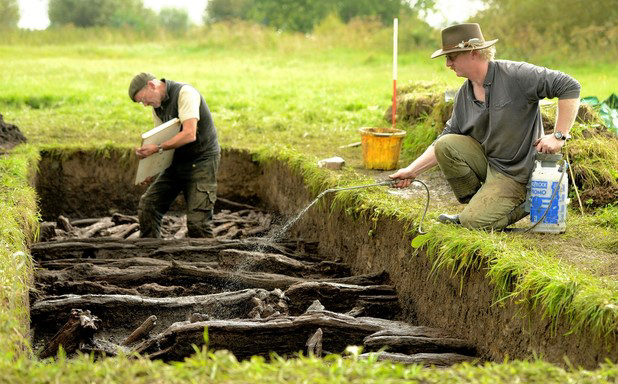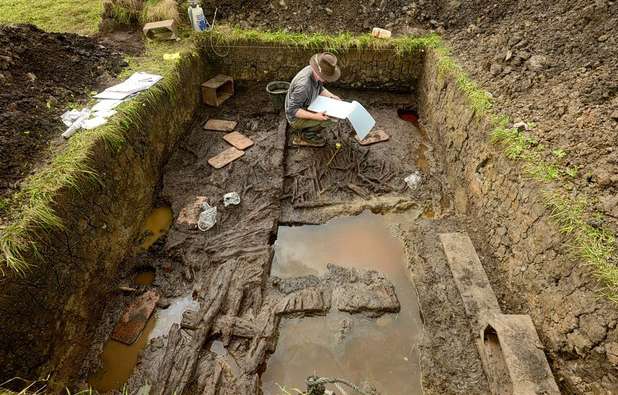


An online article in the Western Daily Press - Archaeologists' dig sheds new light on ancient village - reveals a greater archaeological understanding of Glastonbury's Iron Age Lake Village, Somerset UK. Archaeologists have been carrying out further excavations at the site more than 100 years after its original discovery and excavation.

The waterlogged peat and clay that built up over the village excludes oxygen and so prevents decay, allowing the preservation of a wealth of structures including complex wooden revetments forming the edge of the village. No other prehistoric site in England has this level of preservation.
Although the site is a Scheduled Monument it was not known how much of the archaeology had survived those Victorian investigations. The new work provides information on what survives and at what depth. Some of the timbers show signs of the cracking caused by shrinkage that happened when the wood dried out, probably during an extremely dry summer at some point in the past.
The excavations were carried out by Somerset County Council with funding from English Heritage and the Avalon Marshes Landscape Partnership project.
Tree ring and radiocarbon dating techniques not available to Arthur Bulleid and Harold St George Gray will be used on samples of wood to solve the questions of when, and for how long, the village was occupied. Bulleid's investigations showed that felled trees, bracken, reeds and clay had been brought form elsewhere to create a man-made island of around three and a half acres.
The village grew to a minimum of 18 houses, home to around 200 people, and was protected by a wooden palisade for some of its life. Villagers would have reached it by dug-out canoe, and trackways of wood or hazelrods laid across the marshland. Fragments of pottery, spinning whorls and evidence of bronze casting and iron smelting have been found at the site.

The excavation trenches have now been backfilled and there is nothing to see on the site which is private property owned by the Glastonbury Antiquarian Society, who kindly gave permission for the work to take place.
Some of the unique collection of objects from the original excavations can be seen in two Somerset museums - the Somerset County Museum in Taunton Castle and the Tribunal Museum in the Tourist Information Centre on Glastonbury High Street.
To read more on British prehistory:
http://www.bradshawfoundation.com/british_isles_prehistory_archive/index.php
Comment
by Bradshaw Foundation
Monday 04 December 2023
by Bradshaw Foundation
Friday 30 June 2023
by Bradshaw Foundation
Thursday 06 April 2023
by Bradshaw Foundation
Thursday 24 November 2022
by Bradshaw Foundation
Tuesday 27 September 2022
by Bradshaw Foundation
Thursday 08 September 2022
by Bradshaw Foundation
Tuesday 19 July 2022
by Bradshaw Foundation
Monday 06 June 2022
by Bradshaw Foundation
Friday 11 March 2022
by Bradshaw Foundation
Wednesday 02 March 2022
by Bradshaw Foundation
Thursday 26 August 2021
by Bradshaw Foundation
Monday 16 August 2021
by Bradshaw Foundation
Tuesday 06 July 2021
by Bradshaw Foundation
Thursday 06 May 2021
by Bradshaw Foundation
Thursday 06 May 2021
by Bradshaw Foundation
Tuesday 16 March 2021
by Bradshaw Foundation
Monday 04 December 2023
by Bradshaw Foundation
Friday 30 June 2023
by Bradshaw Foundation
Thursday 06 April 2023
by Bradshaw Foundation
Thursday 24 November 2022
by Bradshaw Foundation
Tuesday 27 September 2022
by Bradshaw Foundation
Thursday 08 September 2022
by Bradshaw Foundation
Tuesday 19 July 2022
by Bradshaw Foundation
Monday 06 June 2022
by Bradshaw Foundation
Friday 11 March 2022
by Bradshaw Foundation
Wednesday 02 March 2022
by Bradshaw Foundation
Thursday 26 August 2021
by Bradshaw Foundation
Monday 16 August 2021
by Bradshaw Foundation
Tuesday 06 July 2021
by Bradshaw Foundation
Thursday 06 May 2021
by Bradshaw Foundation
Thursday 06 May 2021
by Bradshaw Foundation
Tuesday 16 March 2021
Friend of the Foundation











